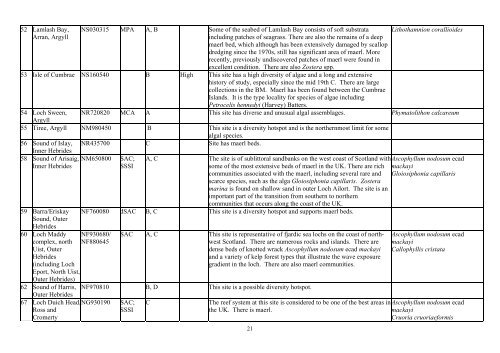Important Plant Areas for algae - Natural History Museum
Important Plant Areas for algae - Natural History Museum
Important Plant Areas for algae - Natural History Museum
Create successful ePaper yourself
Turn your PDF publications into a flip-book with our unique Google optimized e-Paper software.
52 Lamlash Bay,<br />
Arran, Argyll<br />
NS030315 MPA A, B Some of the seabed of Lamlash Bay consists of soft substrata<br />
including patches of seagrass. There are also the remains of a deep<br />
maerl bed, which although has been extensively damaged by scallop<br />
dredging since the 1970s, still has significant area of maerl. More<br />
recently, previously undiscovered patches of maerl were found in<br />
excellent condition. There are also Zostera spp.<br />
53 Isle of Cumbrae NS160540 B High This site has a high diversity of <strong>algae</strong> and a long and extensive<br />
history of study, especially since the mid 19th C. There are large<br />
collections in the BM. Maerl has been found between the Cumbrae<br />
Islands. It is the type locality <strong>for</strong> species of <strong>algae</strong> including<br />
Petrocelis hennedyi (Harvey) Batters.<br />
Lithothamnion corallioides<br />
54 Loch Sween, NR720820 MCA A This site has diverse and unusual algal assemblages. Phymatolithon calcareum<br />
Argyll<br />
55 Tiree, Argyll NM980450 B This site is a diversity hotspot and is the northernmost limit <strong>for</strong> some<br />
algal species.<br />
56 Sound of Islay, NR435700 C Site has maerl beds.<br />
Inner Hebrides<br />
58 Sound of Arisaig, NM650800 SAC;<br />
Ascophyllum nodosum ecad<br />
Inner Hebrides<br />
SSSI<br />
59 Barra/Eriskay<br />
Sound, Outer<br />
Hebrides<br />
60 Loch Maddy<br />
complex, north<br />
Uist, Outer<br />
Hebrides<br />
(including Loch<br />
Eport, North Uist,<br />
Outer Hebrides)<br />
62 Sound of Harris,<br />
Outer Hebrides<br />
67 Loch Duich Head,<br />
Ross and<br />
Cromerty<br />
A, C The site is of sublittoral sandbanks on the west coast of Scotland with<br />
some of the most extensive beds of maerl in the UK. There are rich<br />
communities associated with the maerl, including several rare and<br />
scarce species, such as the alga Gloiosiphonia capillaris. Zostera<br />
marina is found on shallow sand in outer Loch Ailort. The site is an<br />
important part of the transition from southern to northern<br />
communities that occurs along the coast of the UK.<br />
NF760080 dSAC B, C This site is a diversity hotspot and supports maerl beds.<br />
NF930680/<br />
NF880645<br />
SAC A, C This site is representative of fjardic sea lochs on the coast of northwest<br />
Scotland. There are numerous rocks and islands. There are<br />
dense beds of knotted wrack Ascophyllum nodosum ecad mackayi<br />
and a variety of kelp <strong>for</strong>est types that illustrate the wave exposure<br />
gradient in the loch. There are also maerl communities.<br />
NF970810 B, D This site is a possible diversity hotspot.<br />
NG930190<br />
SAC;<br />
SSSI<br />
mackayi<br />
Gloiosiphonia capillaris<br />
Ascophyllum nodosum ecad<br />
mackayi<br />
Callophyllis cristata<br />
C The reef system at this site is considered to be one of the best areas in Ascophyllum nodosum ecad<br />
the UK. There is maerl.<br />
mackayi<br />
Cruoria cruoriae<strong>for</strong>mis<br />
21

















